California is home to a variety of yellow birds, particularly during the spring and summer seasons when warblers and tanagers flock to the area. However, in winter, the most commonly spotted yellow birds are the Yellow-rumped Warbler and lesser goldfinch.
If you’re keen on identifying these yellow birds in California, this guide will provide you with the necessary tools. It includes pictures, identification information, song recordings, and details about their migration patterns.
Most of the yellow birds found in California belong to the warbler, oriole, or tanager families. Interestingly, some female birds look remarkably different from their male counterparts.
With the comprehensive information provided in this guide, identifying yellow birds will become a much simpler task. To assist you further, I have listed these yellow birds in the order of their commonality in California during the spring and summer months (May and June), as per ebird checklists.
Throughout the year, you can spot the following yellow birds in California: Lesser Goldfinch, Orange-crowned Warbler, Common Yellowthroat, American Goldfinch, Western Meadowlark, Orchard Oriole, Baltimore Oriole, and Hooded Warbler.
During the summer months, the following yellow birds can be found in California: Wilson’s Warbler, Yellow Warbler, Hooded Oriole, Western Tanager, Western Kingbird, Yellow-headed Blackbird, Evening Grosbeak, Summer Tanager, and Scott’s Oriole.
In winter, the Yellow-rumped Warbler, Cedar Waxwing, Palm Warbler, Tropical Kingbird, Black-throated Green Warbler, and Painted Bunting are commonly observed.
During migration, keep an eye out for the Nashville Warbler, American Redstart, Magnolia Warbler, Canada Warbler, Prothonotary Warbler, and Dickcissel.
Occasionally, some accidental yellow birds can be spotted in California, including the Prairie Warbler, Pine Warbler, Scarlet Tanager, White-eyed Vireo, Yellow-throated Vireo, Cape May Warbler, Yellow-throated Warbler, Blue-winged Warbler, Streak-backed Oriole, Couch’s Kingbird, Eastern Yellow Wagtail, and Eastern Meadowlark.
So, read on to discover how to identify the yellow birds you have spotted.
29 Yellow Birds in California:
1. Yellow-rumped Warbler:

The Yellow-rumped Warbler is more commonly sighted in California during winter, but some individuals also spend their breeding season in the northern part of the state. They appear in 5% of summer checklists and 48% of winter checklists submitted by birdwatchers in California.
Yellow-rumped Warblers have a gray body with yellow flashes on their face, sides, and rump, and their wings have white patches.
Females may exhibit a slight brownish coloration, while winter birds appear paler brown with vibrant yellow rumps and sides. In spring, their colors transition back to yellow and gray.
Setophaga coronata
Length: 4.7-5.5 inches (12-14 cm)
Weight: 0.4-0.5 ounces (12-13 g)
Wingspan: 7.5-9.1 inches (19-23 cm)
Yellow-rumped Warblers primarily breed in Canada and parts of the Rockies and the Appalachian mountains. During migration, they can be spotted in the Midwest before heading to southern and southwestern U.S. states, the Pacific Coast, Mexico, and Central America.
You’ll find Yellow-rumped Warblers in coniferous forests, particularly during the breeding season. In winter, they can be found in open areas with fruiting shrubs. Their diet consists mainly of insects during summer and migration, while they switch to fruit consumption, including bayberry and wax myrtle, during winter.
Yellow-rumped Warbler Song:
Credit: Christopher McPherson, XC602699. Accessible at www.xeno-canto.org/602699.
Yellow-rumped Warblers build nests in conifer trees using twigs, pine needles, and grass. The nests are lined with soft grass, moss, and hair. They lay up to six eggs, which hatch after approximately two weeks. The young leave the nest about two weeks after hatching.
To attract Yellow-rumped Warblers to your backyard, provide them with sunflower seeds, suet, raisins, and peanut butter.
Fun Fact: In winter, Yellow-rumped Warblers form large flocks numbering in the thousands. They can be quite territorial and aggressive toward other species that encroach upon their space.
2. Lesser Goldfinch:
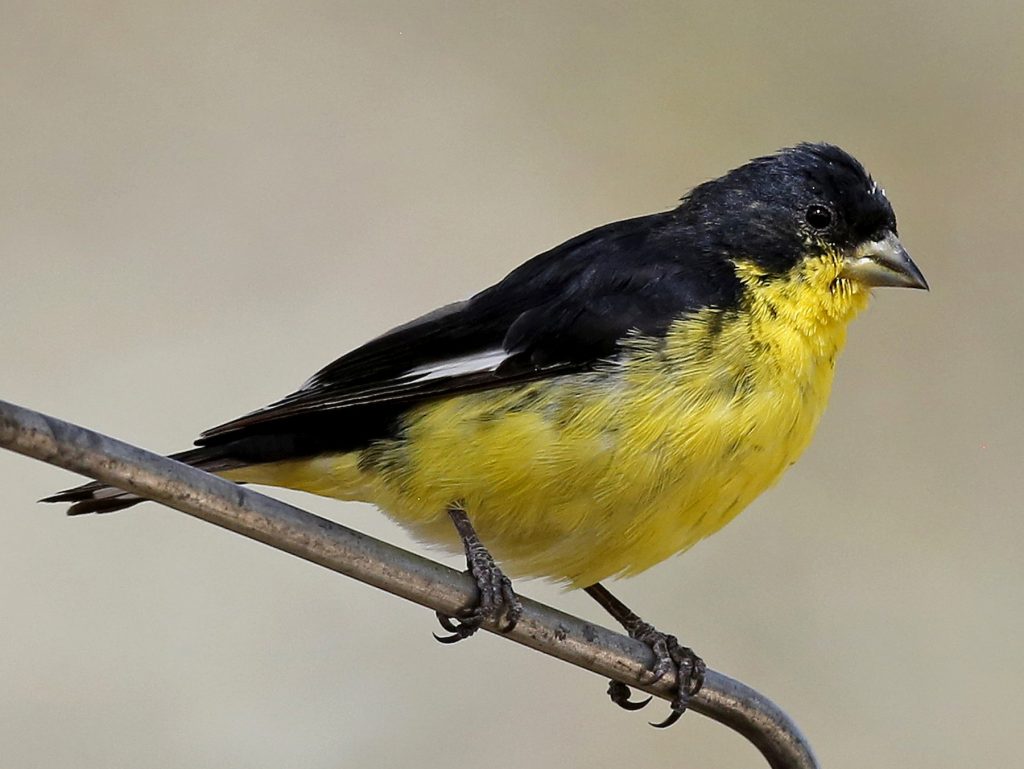
Lesser Goldfinches can be found in California throughout the year. They are seen in 30% of summer checklists and 22% of winter checklists submitted by birdwatchers in the state.
These tiny, brightly colored birds have black and bright yellow plumage, long pointed wings, and short notched tails. Females possess olive backs and exhibit a duller shade of yellow underneath.
Spinus psaltria
Length: 3.5-4.3 inches (9-11 cm)
Weight: 0.3-0.4 ounces (8-11.5 g)
Wingspan: 5.9-7.9 inches (15-20 cm)
Lesser Goldfinches reside in the southwestern U.S. states and along the West Coast throughout the year. However, individuals that breed in the interior of western U.S. states migrate during winter.
You’ll find Lesser Goldfinches in large flocks within open habitats such as thickets, weedy fields, forest clearings, parks, and gardens. They primarily forage for seeds, especially those of sunflowers, and also consume fruits from elderberry, coffeeberry, as well as buds from cottonwoods, willows, sycamores, and alders.
Lesser Goldfinch Call/Song:
Credit: Manuel Grosselet, XC428720. Accessible at www.xeno-canto.org/428720.
Lesser Goldfinches build nests near streams, hidden in trees and shrubs. The nests are constructed using bark, leaves, and other plant materials held together with spiders’ webs. They lay up to six eggs, which take around two weeks to hatch. The young then remain in the nest for an additional two weeks.
To attract Lesser Goldfinches to your yard, offer them sunflower seeds and nyjer in tube feeders or platform feeders.
Fun Fact: Lesser Goldfinches are known to engage in territorial disputes with larger Lawrence’s Goldfinches, often driving them away from feeders and nesting areas. However, they can coexist peacefully with other bird species.
3. Orange-crowned Warbler:

Orange-crowned Warblers are frequently observed during the breeding season in northern California, and their numbers increase during migration periods. Some individuals also remain in the region during winter. They appear in 11% of summer checklists, 8% of winter checklists, and up to 23% of checklists during migrations.
Compared to other warblers, Orange-crowned Warblers are not as vividly colored. They exhibit a yellow-olive hue, which leans more towards yellow along the Pacific Coast. Their orange crown is seldom visible.
Leiothlypis celata
Length: 4.3-5.5 inches (11-14 cm)
Weight: 0.3-0.4 ounces (7-11 g)
Wingspan: 7.5 inches (19 cm)
Orange-crowned Warblers breed in Canada and western U.S. states before embarking on migration to the Pacific, East and Gulf Coasts, and Mexico. During migration, they can be spotted in almost all U.S. states, except the northeastern region.
These warblers tend to inhabit shrubs and low-lying vegetation. However, during the breeding season, they prefer open woodlands. Their diet primarily consists of spiders and insects like caterpillars and flies. Additionally, they feed on fruit, berries, and seeds, often visiting backyard feeders.
Orange-crowned Warbler Song:
Credit: Paul Marvin, XC671865. Accessible at www.xeno-canto.org/671865.
Nests of Orange-crowned Warblers are typically located near or on the ground. They are constructed using dead leaves, twigs, and stems, and lined with soft grass and animal hair. These warblers lay up to six eggs.
To attract Orange-crowned Warblers to your yard, provide them with suet, peanut butter, or hummingbird feeders filled with sugar water nectar.
Fun Fact: Orange-crowned Warblers have been observed drinking from the sapwells created by sapsuckers and woodpeckers.
4. Common Yellowthroat:

Common Yellowthroats can be found in California throughout the year, but they are more frequently sighted during migration from April to June and again from September to December. They are present in 11% of summer checklists and 8% of winter checklists in the state.
These small songbirds exhibit brownish coloring on their backs and vibrant yellow undersides, accompanied by long tails. Males display black masks across their faces, while the brightness of the yellow color can vary geographically. In certain regions, females and juveniles may appear more olive-toned.
Geothlypis trichas
Length: 4.3-5.1 inches (11-13 cm)
Weight: 0.3-0.3 ounces (9-10 g)
Wingspan: 5.9-7.5 inches (15-19 cm)
Common Yellowthroats breed across most of North America, excluding Alaska and northern Canada. Some individuals remain in the Gulf Coast and Pacific Southwest regions year-round, while others migrate south for winter.
These birds are commonly found in marshy or wetland areas, as well as brushy fields with dense vegetation. They primarily reside in thick, tangled vegetation. Common Yellowthroats predominantly feed on insects, including caterpillars, midges, beetles, bugs, and wasps. They also visit backyard feeders and consume fruit, berries, and seeds.
Common Yellowthroat Song:
Credit: Paul Marvin, XC629250. Accessible at www.xeno-canto.org/629250.
Nests of Common Yellowthroats are constructed by females near the ground in marshy areas. They are supported by reeds and made from grass and sedges, forming a cup shape. The nests are lined with leaves and grass. Common Yellowthroats lay up to six eggs, which take around twelve days to hatch. The young then leave the nest after a similar duration.
To attract Common Yellowthroats to your backyard, provide dense vegetation and native plants that attract insects.
Fun Fact: The black mask exhibited by male Common Yellowthroats serves as a signal to courting males. They become territorial and will attack models of birds with masks. However, they do not exhibit the same response when the model lacks a mask.
5. American Goldfinch:
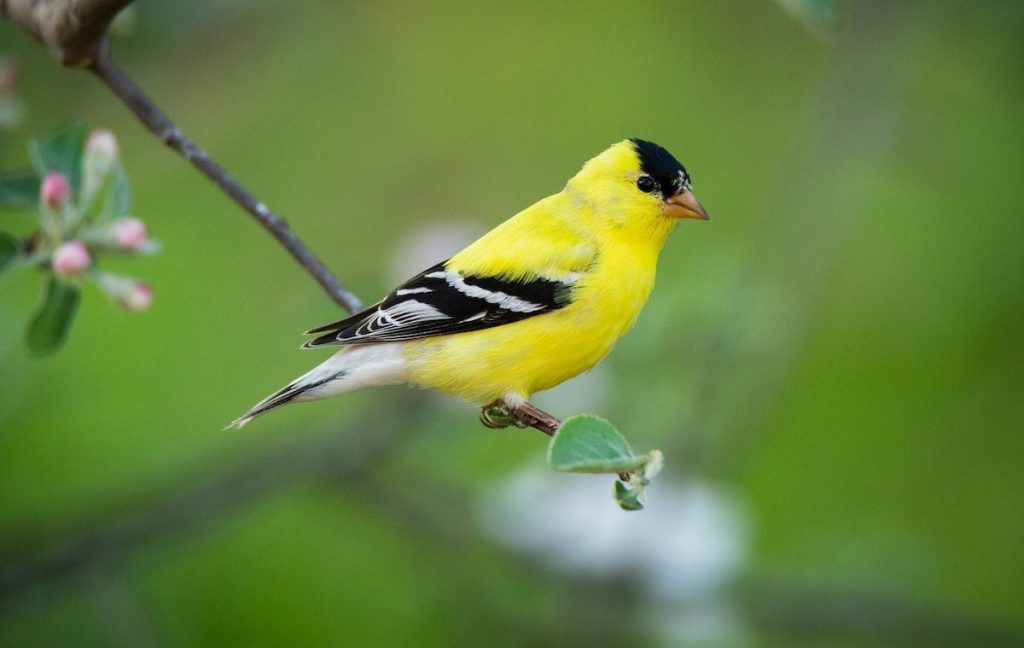
American Goldfinches can be seen in California throughout the year, with increased numbers during migrations in April and November. They are present in approximately 9% of summer and
winter checklists, and up to 11% of checklists during migrations.
These popular birds are known for the vibrant black and yellow coloring displayed by males during spring. Females and males in winter exhibit a more subdued brownish plumage.
Spinus tristis
Length: 4.3-5.1 inches (11-13 cm)
Weight: 0.4-0.7 ounces (11-20 g)
Wingspan: 7.5-8.7 inches (19-22 cm)
American Goldfinches are found throughout most of North America and are generally residents all year. However, individuals that breed in Canada and the Midwest migrate to southern U.S. states during winter.
These finches can be spotted in various habitats, including weedy fields, overgrown areas, forests, suburbs, parks, and backyards. They primarily forage for seeds, particularly those of sunflowers, and also consume fruits from elderberry and coffeeberry. American Goldfinches are frequent visitors to bird feeders, where they prefer sunflower and nyjer seeds.
American Goldfinch Song:
Nests of American Goldfinches are typically located in shrubs and are constructed using rootlets, plant material, and bark. The nests are held together with spiders’ webs and lined with pine needles and soft grass. American Goldfinches lay up to seven eggs, which hatch after approximately two weeks. The young remain in the nest for two to two and a half weeks.
To attract American Goldfinches to your backyard, plant thistles and milkweed. They will visit most bird feeders, with a preference for sunflower and nyjer seeds.
Fun Fact: American Goldfinches have a strictly vegetarian diet, which makes them unsuitable hosts for cowbird chicks. Cowbirds lay their eggs in other birds’ nests, but their young cannot survive on the vegetarian diet of American Goldfinches.
6. Western Meadowlark:

Western Meadowlarks can be observed throughout the year in California, but they are more commonly sighted in the southern part of the state during winter (October to March). They are recorded in 5% of summer checklists and 11% of winter checklists.
These birds, known for their bright yellow bellies and melodious songs, can bring joy to any observer.
Western Meadowlarks belong to the blackbird family and are similar in size to Robins. They exhibit shades of brown and white on their upperparts, with a black V-shaped band across their bright yellow chests, which turns gray during winter.
Sturnella neglecta
Length: 6.3-10.2 inches (16-26 cm)
Weight: 3.1-4.1 ounces (89-115 g)
Wingspan: 16.1 inches (41 cm)
Western Meadowlarks that breed in northern U.S. states and Canada migrate to more southern states during winter. However, individuals residing in the western and midwestern regions remain year-round.
These birds can usually be found on the ground in grasslands, meadows, and fields. They forage alone or in small flocks, preferring open habitats over woods or dense shrubs.
Western Meadowlarks have an insect-based diet during summer, while they consume more seeds and grains during winter.
Western Meadowlark Sounds: They produce a series of pleasant tweets, warbles, and whistles.
Credit: Matt Wistrand, XC638594. Accessible at www.xeno-canto.org/638594.
Nests of Western Meadowlarks are located in depressions on the ground in grasslands. They are constructed using soft materials like grass, with a roof made of grass and plant stalks.
To attract Western Meadowlarks to your backyard, offer them sunflower seeds and cracked corn.
Fun Fact: Western Meadowlarks have been chosen as the state bird for six U.S. states.
7. Wilson’s Warbler:

Wilson’s Warblers are commonly seen during the breeding season in California, with increased numbers during migrations in May and September. They occur in 13% of summer checklists and up to 25% of checklists during migrations.
These tiny, round yellow warblers exhibit a large black cap in males and a smaller black cap in females.
Cardellina pusilla
Length: 3.9-4.7 inches (10-12 cm)
Weight: 0.2-0.3 ounces (5-10 g)
Wingspan: 5.5-6.7 inches (14-17 cm)
Wilson’s Warblers breed in Canada, Alaska, and northwestern U.S. states, and can be seen across all U.S. states during migration. They spend the winter months in Mexico and Central America.
These warblers can be found along streams in thickets and near forest edges, where they forage for insects, larvae, and spiders.
Wilson’s Warbler Song:
Credit: Thomas G. Graves, XC561438. Accessible at www.xeno-canto.org/561438.
Nests of Wilson’s Warblers are well-hidden on the ground near trees or shrubs. They are made from leaves, sedges, and woven grass, lined with soft grass and animal hair. Wilson’s Warblers lay around five eggs, which hatch after approximately eleven days. The young then leave the nest within ten days.
To attract Wilson’s Warblers to your backyard, plant native trees and shrubs. However, they do not typically visit feeders.
Fun Fact: Wilson’s Warblers employ a clever distraction technique when potential nest predators are nearby. They pretend to have a broken wing, luring the predator away before flying off.
8. Cedar Waxwing:
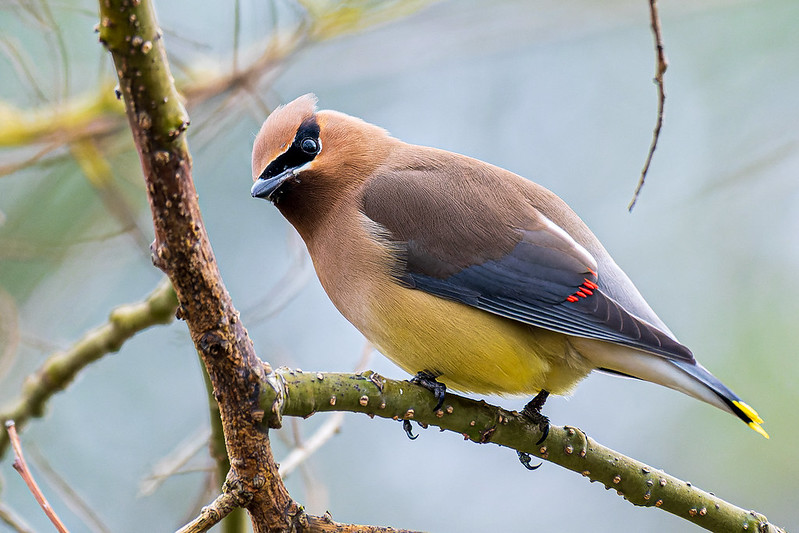
Cedar Waxwings are primarily seen in California during winter and occur in 7% of checklists at this time. However, some individuals can be observed throughout the year.
These elegant, social birds have pale brown heads, chests, and crests, which transition to gray on their backs and wings. Their bellies are pale yellow, and they sport bright yellow tips on their wings. A narrow black mask adorns their eyes, and their wingtips exhibit a vibrant red hue.
Bombycilla cedrorum
Length: 5.5-6.7 inches (14-17 cm)
Weight: 1.1 ounce (32 g)
Wingspan: 8.7-11.8 inches (22-30 cm)
Cedar Waxwings breed in Canada before migrating to the southern U.S., Mexico, and Central America for winter. Some individuals remain year-round in northern U.S. states.
These birds can be found in berry bushes, woodlands, grasslands, towns, and along streams. They primarily feed on fruit but also consume insects during summer.
Cedar Waxwing Call:
Credit: Peter Ward and Ken Hall, XC512254. Accessible at www.xeno-canto.org/512254.
Nests of Cedar Waxwings are built in trees using twigs, grass, hair, and plant materials. They are lined with pine needles and soft grass. Cedar Waxwings lay up to six eggs, which hatch after approximately twelve days. The young leave the nest within about sixteen days.
To attract Cedar Waxwings to your backyard, plant native trees and shrubs with small fruits such as serviceberry, dogwood, juniper, winterberry, and hawthorn. You can also try offering fruit on platform feeders.
Fun Fact: Cedar Waxwings engage in gift-giving behavior during courtship. They pass gifts between potential mates.
9. Yellow Warbler:

Yellow Warblers are primarily observed in California from April to October, with increased numbers during migrations. They occur in up to 10% of summer checklists and up to 21% of checklists during migrations.
These small, bright yellow birds feature a yellow-green back, with males exhibiting chestnut streaks on the breast. Females and juveniles are not as vibrant as males.
Setophaga petechia
Length: 4.7-5.1 inches (12-13 cm)
Weight: 0.3-0.4 ounces (9-11 g)
Wingspan: 6.3-7.9 inches (16-20 cm)
Yellow Warblers undertake a long-distance migration, breeding in Canada and the U.S. (except southeastern states) before heading to Central and South America for winter. However, they can be seen during migration in southeastern U.S. states.
These warblers are commonly found along streams, wetlands, thickets, and field edges. They forage for insects, including caterpillars, midges, beetles, bugs, and wasps.
Yellow Warbler Song:
Credit: Richard E. Webster, XC662546. Accessible at www.xeno-canto.org/662546.
Nests of Yellow Warblers are typically constructed in small trees or shrubs. They are made from bark, grass, and woven plant materials, held together with spiders’ webs. The nests are lined with softer materials like hair, feathers, and plant down.
Yellow Warblers lay up to seven eggs, which hatch after approximately twelve days. The young leave the nest after about ten days.
To attract Yellow Warblers to your backyard, provide suet, oranges, peanut butter, and plants with berries. Additionally, plant native vegetation that attracts insects, and avoid using pesticides or maintaining an overly tidy yard. Birdbaths with fountains near secluded plantings can also offer protection.
Fun Fact: Yellow Warblers exhibit a fascinating behavior when encountering cowbird eggs in their nests. If they detect a cowbird egg, they construct a new nest on top of the old one and start over, sometimes repeating this process up to six times!
10. Hooded Oriole:

Hooded Orioles spend the breeding season in California and can be observed from March to September. They occur in 11% of summer checklists.
Male Hooded Orioles display a range of bright yellow to vibrant orange hues, with black throats and backs. Females and immatures exhibit more yellow coloring with grayish wings. Females lack the black face markings seen in males.
Icterus cucullatus
Length: 7.1-7.9 inches (18-20 cm)
Weight: 0.8 ounce (24 g)
Wingspan: 9.1-11.0 inches (23-28 cm)
Hooded Orioles breed in the southern U.S. states, constructing hanging nests on the undersides of palm fronds. They migrate to Mexico for winter, while some individuals remain year-round on the Gulf Coast of Mexico and in Central America.
Some Hooded Orioles have ceased migrating from southern U.S. states due to the availability of food from nectar feeders and fruits provided by birdwatchers. They typically inhabit dry, open areas, especially near palm trees.
Hooded Oriole Sounds: Males produce a complex mix of whistles and warbles, while females have less intricate songs. Both genders emit sharp calls.
Credit: Paul Marvin, XC571093. Accessible at www.xeno-canto.org/571093.
Nests of Hooded Orioles are situated at a height of approximately 20 feet off the ground, hanging from trees. These basket-like nests are woven from grass and plant materials.
To attract Hooded Orioles to your backyard, offer sugar water, jelly, and oranges.
Fun Fact: Hooded Oriole males in Texas tend to exhibit orange coloration, while those further west are more yellow.
11. Baltimore Oriole:
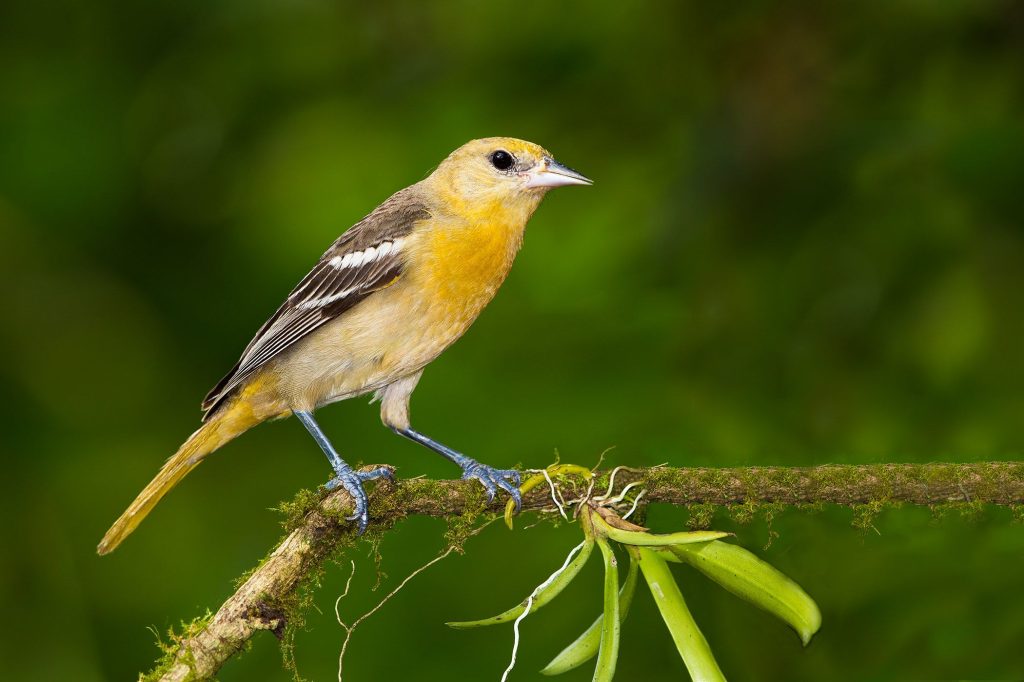
Baltimore Orioles can be spotted in California during the breeding season, typically from April to September. They occur in 10% of summer checklists.
These striking birds showcase bright orange plumage, with black heads, wings, and tails. Females have a more subdued coloration with a mix of orange and yellow.
Icterus galbula
Length: 7.5-8.7 inches (19-22 cm)
Weight: 1.0-1.2 ounces (28-34 g)
Wingspan: 9.8-11.8 inches (25-30 cm)
Baltimore Orioles breed in the eastern and central parts of North America, including parts of Canada and the U.S. Midwest. They migrate to Central and South America for winter.
These orioles can be found in open woodlands, forest edges, and parks. They have a diverse diet, feeding on nectar, fruit, insects, and spiders.
Baltimore Oriole Song:
Credit: Ted Floyd, XC610004. Accessible at www.xeno-canto.org/610004.
Nests of Baltimore Orioles are intricately woven using plant fibers, grass, and other materials, and are suspended from branches. They lay up to six eggs, which hatch after approximately two weeks. The young leave the nest within two weeks as well.
To attract Baltimore Orioles to your backyard, provide nectar feeders filled with sugar water, as well as offerings of orange slices and grape jelly.
Fun Fact: Baltimore Orioles are known for their unique hanging nests, which can sometimes resemble a gourd or a woven sock.
12. Hooded Warbler:
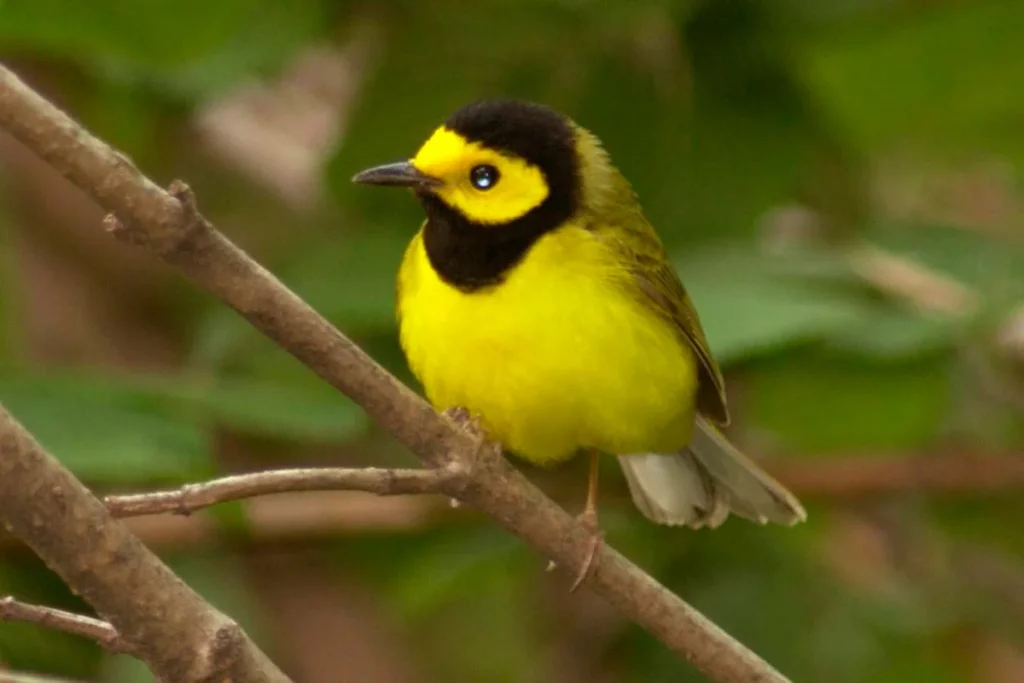
Hooded Warblers are frequently seen in California during the breeding season, typically from April to September. They occur in 6% of summer checklists.
These small warblers exhibit a vibrant yellow color with a black hood and throat in males, while females display a duller olive coloration.
Setophaga citrina
Length: 4.3-5.1 inches (11-13 cm)
Weight: 0.3-0.4 ounces (8-11 g)
Wingspan: 6.3-7.9 inches (16-20 cm)
Hooded Warblers breed in the eastern and southeastern parts of the United States before migrating to Central and South America for winter.
These warblers are typically found in deciduous forests with dense understory vegetation. They primarily feed on insects and spiders.
Hooded Warbler Song:
Credit: Andrew Spencer, XC582775. Accessible at www.xeno-canto.org/582775.
Nests of Hooded Warblers are built on or close to the ground, often hidden within shrubs or leaf litter. They are constructed using grasses, leaves, and other plant materials, lined with fine grasses and hair. Hooded Warblers lay around four to five eggs, which hatch after approximately 12-13 days. The young leave the nest within 10-11 days.
To attract Hooded Warblers to your backyard, maintain dense shrubbery and provide a water source.
Fun Fact: Hooded Warblers are known for their distinctive breeding display, where the male fans out its tail feathers and raises its hood to attract females.
13. Orchard Oriole:
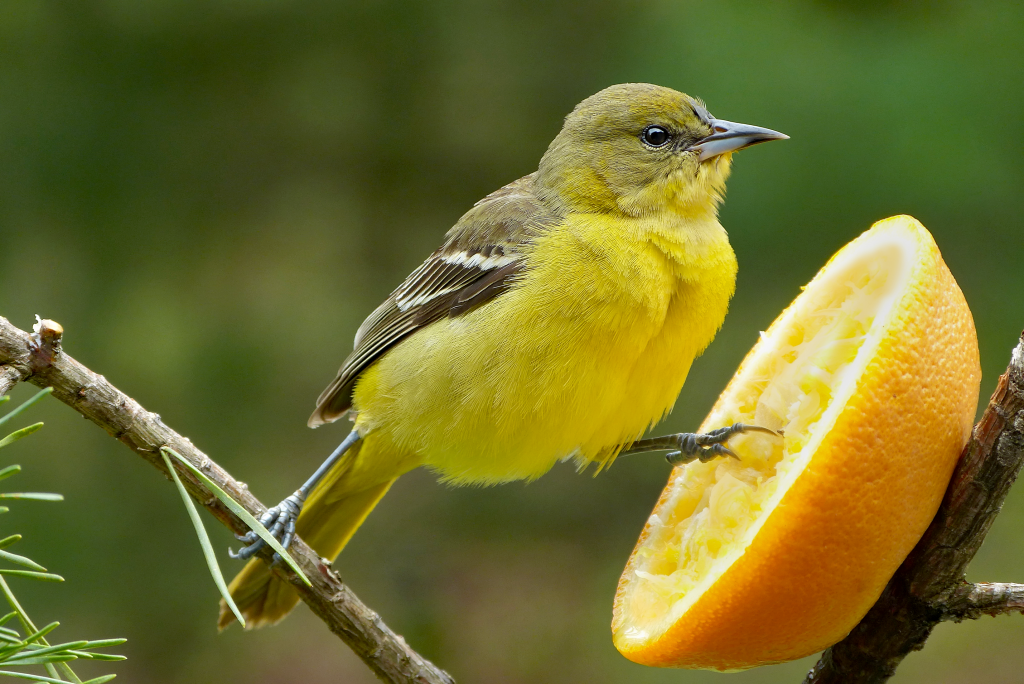
Orchard Orioles can be observed in California during the breeding season, typically from April to September. They occur in 4% of summer checklists.
Male Orchard Orioles showcase a striking mix of bright orange and black plumage, while females have a more subdued yellowish-green coloration.
Icterus spurius
Length: 5.9-6.3 inches (15-16 cm)
Weight: 0.6-0.8 ounces (17-23 g)
Wingspan: 9.4-10.2 inches (24-26 cm)
Orchard Orioles breed in the eastern and central parts of North America and migrate to Mexico and Central America for winter.
These orioles can be found in open woodlands, orchards, and forest edges. They feed on insects, nectar, and fruit.
Orchard Oriole Song:
Credit: James Bradley, XC612754. Accessible at www.xeno-canto.org/612754.
Nests of Orchard Orioles are built by females, often in deciduous trees such as cottonwoods or maples. The nests are woven using plant fibers, grass, and other materials, and are suspended from branches. They lay up to five eggs, which hatch after approximately two weeks. The young leave the nest within two weeks as well.
To attract Orchard Orioles to your backyard, provide offerings of fruit, nectar feeders, and small insects.
Fun Fact: Orchard Orioles are the smallest orioles found in North America.
14. Wilson’s Warbler:
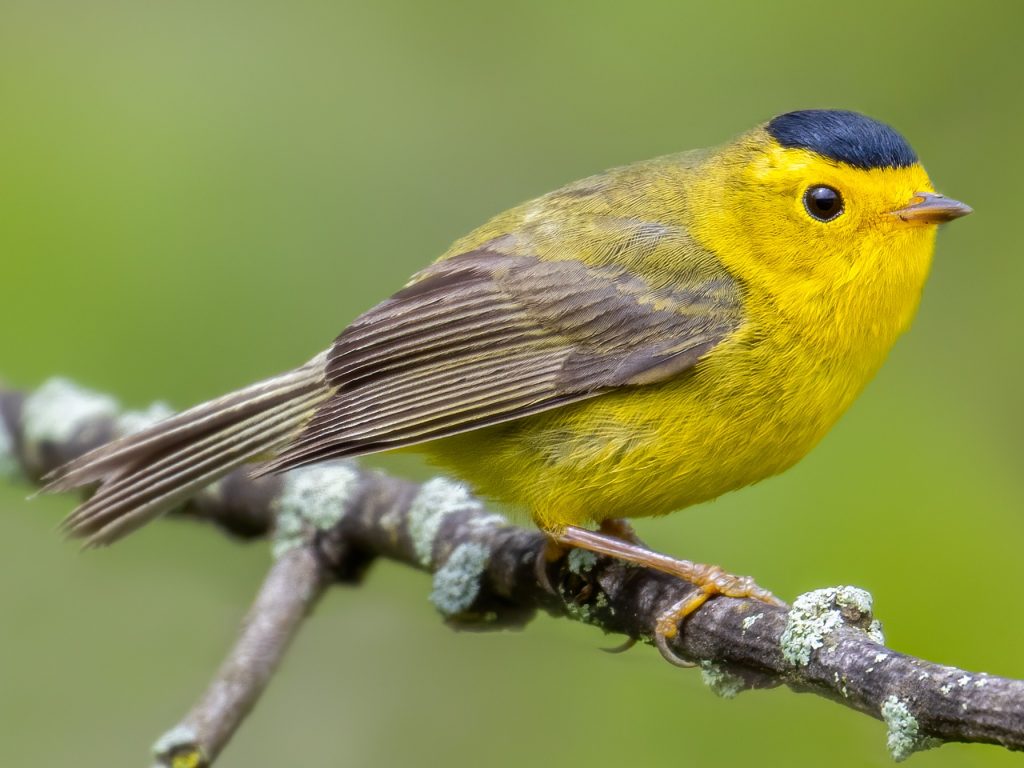
Wilson’s Warblers are commonly spotted in California during the breeding season, with increased numbers during migrations in May and September. They occur in 13% of summer checklists and up to 25% of checklists during migrations.
These tiny, round yellow warblers exhibit a large black cap in males and a smaller black cap in females.
Cardellina pusilla
Length: 3.9-4.7 inches (10-12 cm)
Weight: 0.2-0.3 ounces (5-10 g)
Wingspan: 5.5-6.7 inches (14-17 cm)
Wilson’s Warblers breed in Canada, Alaska, and northwestern U.S. states, and can be seen across all U.S. states during migration. They spend the winter months in Mexico and Central America.
You can find Wilson’s Warblers along streams in thickets and near forest edges, where they forage for insects and their larvae, as well as spiders.
Wilson’s Warbler Song:
Credit: Thomas G. Graves, XC561438. Accessible at www.xeno-canto.org/561438.
Nests of Wilson’s Warblers are well-hidden on the ground near trees or shrubs. They are made from leaves, sedges, and woven grass, lined with soft grass and animal hair. They lay around five eggs, which take approximately eleven days to hatch. The young then leave the nest within ten days.
To attract Wilson’s Warblers to your backyard, plant native trees and shrubs, but note that they do not typically visit feeders.
Fun Fact: Wilson’s Warblers employ a clever distraction technique when potential nest predators are nearby. They pretend to have a broken wing, luring the predator away before flying off.
15. Yellow-headed Blackbird:

Yellow-headed Blackbirds can be observed in California during the breeding season, typically from April to September. They occur in 6% of summer checklists.
Male Yellow-headed Blackbirds are easily recognized by their vibrant yellow heads, black bodies, and white wing patches. Females have a more subdued coloration, with streaked brown and yellow plumage.
Xanthocephalus xanthocephalus
Length: 9.1-10.6 inches (23-27 cm)
Weight: 2.7-3.4 ounces (76-96 g)
Wingspan: 14.2-16.1 inches (36-41 cm)
Yellow-headed Blackbirds breed in marshes and wetlands across western North America, including parts of Canada and the United States. They migrate to southwestern U.S. states and Mexico for winter.
These blackbirds primarily inhabit marshes, wetlands, and meadows. They feed on insects, seeds, and grains.
Yellow-headed Blackbird Sounds: Males emit a variety of harsh and rattling calls.
Credit: Jason G. Goldman, XC574612. Accessible at www.xeno-canto.org/574612.
Nests of Yellow-headed Blackbirds are built over water, suspended from cattails or other emergent vegetation. They are constructed using cattail leaves and other plant materials, and lined with fine grasses. They lay around three to six eggs, which hatch after approximately ten days. The young leave the nest within two weeks.
To attract Yellow-headed Blackbirds to your backyard, create wetland-like habitat with suitable vegetation and provide offerings of seeds and insects.
Fun Fact: Male Yellow-headed Blackbirds are highly territorial and defend their nesting territories fiercely, often engaging in aggressive displays and vocalizations.
16. Evening Grosbeak:
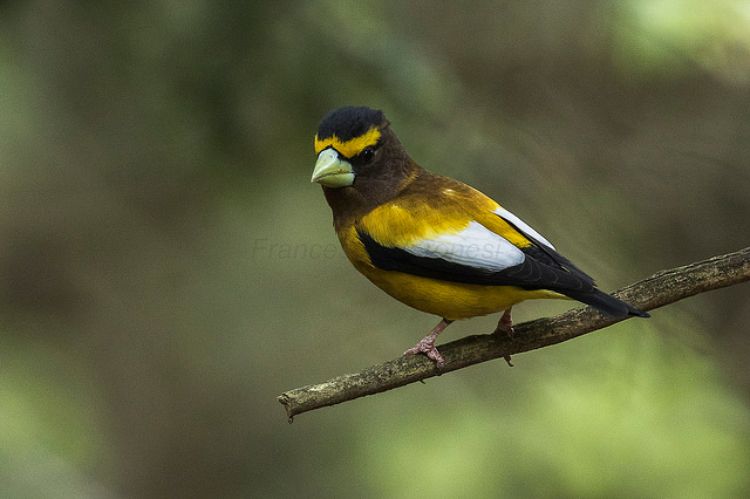
Evening Grosbeaks can be spotted in California during the winter months, typically from October to March. They occur in 9% of winter checklists.
These robust, stocky finches display a striking combination of yellow, black, and white plumage. Males have bright yellow bodies with black wings and white wing patches, while females exhibit a more subdued yellowish-green coloration.
Coccothraustes vespertinus
Length: 6.7-7.9 inches (17-20 cm)
Weight: 1.4-1.8 ounces (40-51 g)
Wingspan: 11.4-12.2 inches (29-31 cm)
Evening Grosbeaks breed in coniferous forests of western North America, including parts of Canada and the U.S. Rocky Mountains. They are known for their irruptive migration patterns, with unpredictable movements in search of food. During winter, they can be found in various locations.
These grosbeaks feed on a diverse diet, including seeds, buds, fruits, and insects.
Evening Grosbeak Call:
Credit: Craig Mullen, XC540201. Accessible at www.xeno-canto.org/540201.
Nests of Evening Grosbeaks are built on horizontal branches of conifer trees, typically 15-60 feet above the ground. They are constructed using twigs, grass, lichen, and moss, and lined with fine grasses and rootlets. They lay up to four eggs, which hatch after approximately twelve days. The young leave the nest within two weeks.
To attract Evening Grosbeaks to your backyard, provide a variety of seeds and fruits in feeders and plant native trees that bear fruits and nuts.
Fun Fact: Evening Grosbeaks have powerful beaks that allow them to crush and open seeds that many other birds cannot access.
17. Summer Tanager:

Summer Tanagers are commonly seen in California during the breeding season, typically from April to September. They occur in 3% of summer checklists.
Male Summer Tanagers are vibrant crimson in color, while females exhibit a yellowish-green plumage, gradually transitioning to yellow in the underparts.
Piranga rubra
Length: 6.3-7.1 inches (16-18 cm)
Weight: 0.7-1.0 ounce (19-29 g)
Wingspan: 9.8-10.6 inches (25-27 cm)
Summer Tanagers breed in the southeastern and southwestern parts of the United States and migrate to Mexico and Central America for winter.
These tanagers can be found in woodlands, forests, and edges of open areas. They primarily feed on insects, including bees, wasps, and beetles.
Summer Tanager Song:
Credit: Richard E. Webster, XC679996.
Accessible at www.xeno-canto.org/679996.
Nests of Summer Tanagers are usually located in trees or shrubs, constructed using twigs, grass, bark, and plant fibers. They lay up to four eggs, which hatch after approximately two weeks. The young leave the nest within two weeks as well.
To attract Summer Tanagers to your backyard, provide a water source and maintain suitable woodland habitat.
Fun Fact: Summer Tanagers are known for their unique feeding behavior called “beetling.” They catch flying insects in mid-air, often pursuing them on the wing.
18. Scott’s Oriole:

Scott’s Orioles can be observed in California during the breeding season, typically from April to September. They occur in 4% of summer checklists.
Male Scott’s Orioles display a striking combination of bright yellow and black plumage, with a black face mask. Females have a more subdued yellowish coloration.
Icterus parisorum
Length: 7.5-8.3 inches (19-21 cm)
Weight: 1.0-1.3 ounces (28-37 g)
Wingspan: 10.2-11.0 inches (26-28 cm)
Scott’s Orioles breed in the southwestern parts of the United States and northern Mexico. Some populations are resident year-round, while others migrate short distances.
These orioles inhabit open woodlands, desert scrub, and canyon areas. They feed on insects, nectar, and fruits.
Scott’s Oriole Song:
Credit: Phil Gregory, XC655963. Accessible at www.xeno-canto.org/655963.
Nests of Scott’s Orioles are typically built at the tips of high branches in trees such as oak or mesquite. They are constructed using grass, bark strips, and plant fibers, and lined with fine grasses and hair. They lay up to five eggs, which hatch after approximately two weeks. The young leave the nest within two weeks as well.
To attract Scott’s Orioles to your backyard, provide offerings of nectar feeders, oranges, and grape jelly.
Fun Fact: Scott’s Orioles have a unique feeding technique where they stab the base of flowers to extract nectar, rather than entering the flower itself.
19. Yellow-rumped Warbler:

Yellow-rumped Warblers are more frequently spotted in California during winter, but some also spend the breeding season in the north of the state. They are recorded in 5% of summer checklists and 48% of winter checklists submitted by birdwatchers in the state.
These warblers have a gray overall appearance with flashes of yellow on the face, sides, and rump, as well as white in the wings.
Setophaga coronata
Length: 4.7-5.5 inches (12-14 cm)
Weight: 0.4-0.5 ounce (12-13 g)
Wingspan: 7.5-9.1 inches (19-23 cm)
Yellow-rumped Warblers predominantly breed in Canada and parts of the Rockies and the Appalachian mountains.
They can be seen in the Midwest during migration before overwintering in southern and southwestern U.S. states, the Pacific Coast, Mexico, and Central America.
You can find Yellow-rumped Warblers in coniferous forests, especially during the breeding season. During winter, they can be found in open areas with fruiting shrubs. In summer, they primarily feed on insects, and during migration and winter, they consume mostly fruit, including bayberry and wax myrtle.
Yellow-rumped Warbler Song:
Credit: Christopher McPherson, XC602699. Accessible at www.xeno-canto.org/602699.
Nests of Yellow-rumped Warblers are made by females
in conifer trees, often near the trunk, using twigs, grass, moss, and feathers, and lined with finer materials. They lay around four to five eggs, which hatch after approximately twelve days. The young leave the nest within ten days.
To attract Yellow-rumped Warblers to your backyard, provide fruit-bearing shrubs and trees, suet, and insects.
Fun Fact: Yellow-rumped Warblers are highly adaptable and are known to switch their diet from insects to fruit during winter when insects are scarce.
20. Lazuli Bunting:
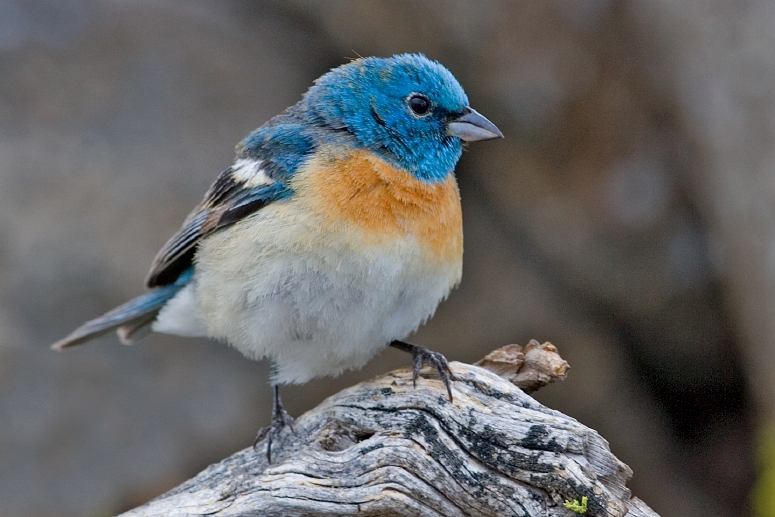
Lazuli Buntings are frequently seen in California during the breeding season, typically from April to September. They occur in 13% of summer checklists.
Male Lazuli Buntings are characterized by their stunning sky-blue plumage with a rusty-orange throat and breast. Females exhibit a brownish coloration.
Passerina amoena
Length: 4.3-5.1 inches (11-13 cm)
Weight: 0.4-0.5 ounce (12-14 g)
Wingspan: 7.5-8.3 inches (19-21 cm)
Lazuli Buntings breed in the western parts of North America, including parts of Canada and the United States. They migrate to Mexico and Central America for winter.
These buntings can be found in open woodlands, brushy areas, and along streamside vegetation. They primarily feed on insects and seeds.
Lazuli Bunting Song:
Credit: Andrew Spencer, XC603083. Accessible at www.xeno-canto.org/603083.
Nests of Lazuli Buntings are built by females, often in shrubs or small trees, using grass, bark, leaves, and other plant materials, and lined with fine grasses and hair. They lay up to four eggs, which hatch after approximately twelve days. The young leave the nest within two weeks as well.
To attract Lazuli Buntings to your backyard, provide offerings of seeds, insects, and maintain suitable habitat with shrubs and trees.
Fun Fact: Lazuli Buntings are known for their beautiful song and are sometimes referred to as “sky-blue songbirds.”
21. Nashville Warbler:
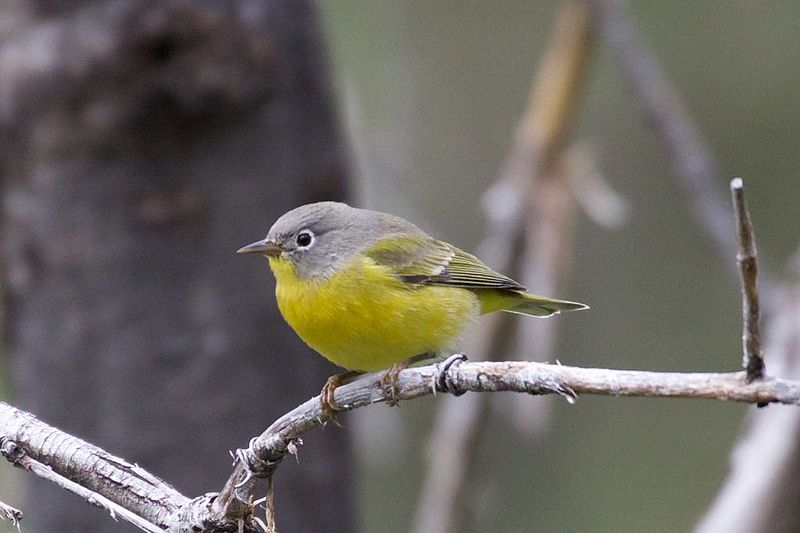
Nashville Warblers can be spotted in California during migration seasons, particularly in the spring and fall. They occur in up to 7% of checklists during migrations.
These small warblers have olive-green upperparts and a yellowish underbelly with a white eye ring. They also exhibit a gray head and a prominent white throat patch.
Leiothlypis ruficapilla
Length: 4.3-4.7 inches (11-12 cm)
Weight: 0.3-0.4 ounce (7-10 g)
Wingspan: 6.7-7.1 inches (17-18 cm)
Nashville Warblers breed in Canada and parts of the northern United States, migrating through California on their way to their wintering grounds in Mexico and Central America.
These warblers prefer areas with dense foliage, such as forests, woodlands, and shrubby habitats. They primarily feed on insects, spiders, and berries.
Nashville Warbler Song:
Credit: Robins Edwards, XC604253. Accessible at www.xeno-canto.org/604253.
Nests of Nashville Warblers are usually built on or near the ground, hidden among vegetation. They are constructed using grass, moss, and plant fibers, and lined with fine grasses and hair. They lay around four to five eggs, which hatch after approximately two weeks. The young leave the nest within ten days.
To attract Nashville Warblers, provide dense shrubs and foliage, as well as insects and berries as a food source.
Fun Fact: Nashville Warblers were named after the city of Nashville, Tennessee, where the species was first discovered.
22. American Redstart:
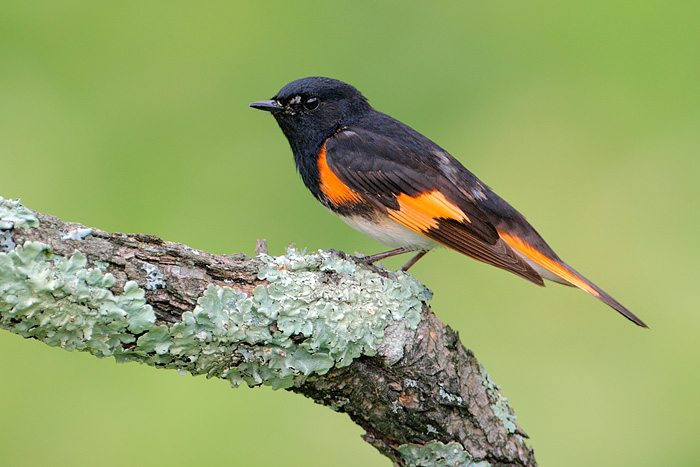
American Redstarts are commonly seen in California during migration seasons, particularly in the spring and fall. They occur in up to 15% of checklists during migrations.
These small warblers display a striking black and orange plumage. Males have vibrant orange patches on their wings and tails, while females exhibit more subdued yellow and gray coloration.
Setophaga ruticilla
Length: 4.3-5.1 inches (11-13 cm)
Weight: 0.3-0.4 ounce (9-11 g)
Wingspan: 6.7-7.5 inches (17-19 cm)
American Redstarts breed in eastern and central parts of North America and migrate through California to their wintering grounds in Mexico, Central America, and the Caribbean.
These warblers prefer wooded areas, forests, and streamside vegetation. They are known for their active foraging behavior, constantly fluttering their wings and flicking their tails as they search for insects.
American Redstart Song:
Credit: Andrew Spencer, XC400078. Accessible at www.xeno-canto.org/400078.
Nests of American Redstarts are built by females, usually in the understory of deciduous trees, using twigs, grass, bark, and other materials. They lay around three to five eggs, which hatch after approximately two weeks. The young leave the nest within ten days.
To attract American Redstarts, provide suitable habitat with trees and shrubs, as well as insects as a food source.
Fun Fact: Male American Redstarts are known for their unique “flash-and-sit” hunting technique. They flash their colorful wings and tails to flush out insects, then rapidly sit to snatch them in mid-air.
23. Magnolia Warbler:
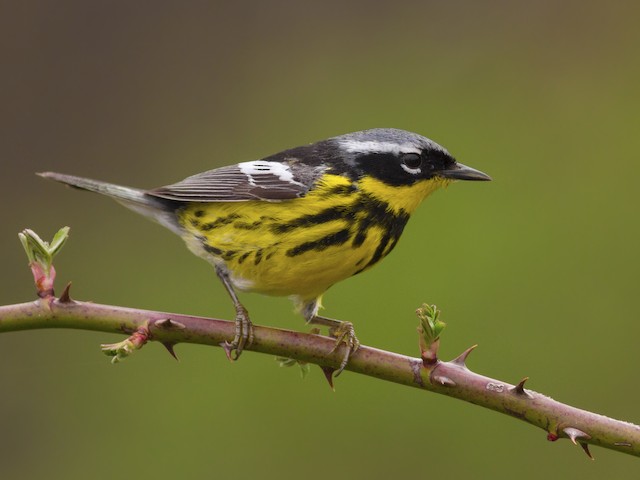
Magnolia Warblers can be observed in California during migration seasons, particularly in the spring and fall. They occur in up to 12% of checklists during migrations.
These warblers have a black and yellow plumage, with striking black streaks on their yellow underparts. They also
exhibit a white eye ring and a black mask across their face.
Setophaga magnolia
Length: 4.3-5.1 inches (11-13 cm)
Weight: 0.3-0.4 ounce (9-11 g)
Wingspan: 6.7-7.5 inches (17-19 cm)
Magnolia Warblers breed in the boreal forests of Canada and parts of the northeastern United States. They migrate through California on their way to their wintering grounds in Mexico and Central America.
These warblers prefer forests, woodlands, and dense shrubby areas. They primarily feed on insects, caterpillars, and spiders.
Magnolia Warbler Song:
Credit: Jonathon Jongsma, XC617375. Accessible at www.xeno-canto.org/617375.
Nests of Magnolia Warblers are usually located on the ground or near the base of shrubs, hidden among vegetation. They are constructed using twigs, grass, moss, and bark strips, and lined with fine grasses and hair. They lay around four to five eggs, which hatch after approximately two weeks. The young leave the nest within ten days.
To attract Magnolia Warblers, provide dense shrubs and foliage, as well as insects and caterpillars as a food source.
Fun Fact: Despite its name, the Magnolia Warbler does not have a significant association with magnolia trees. It was named after a French botanist named Pierre Magnol.
24. Canada Warbler:
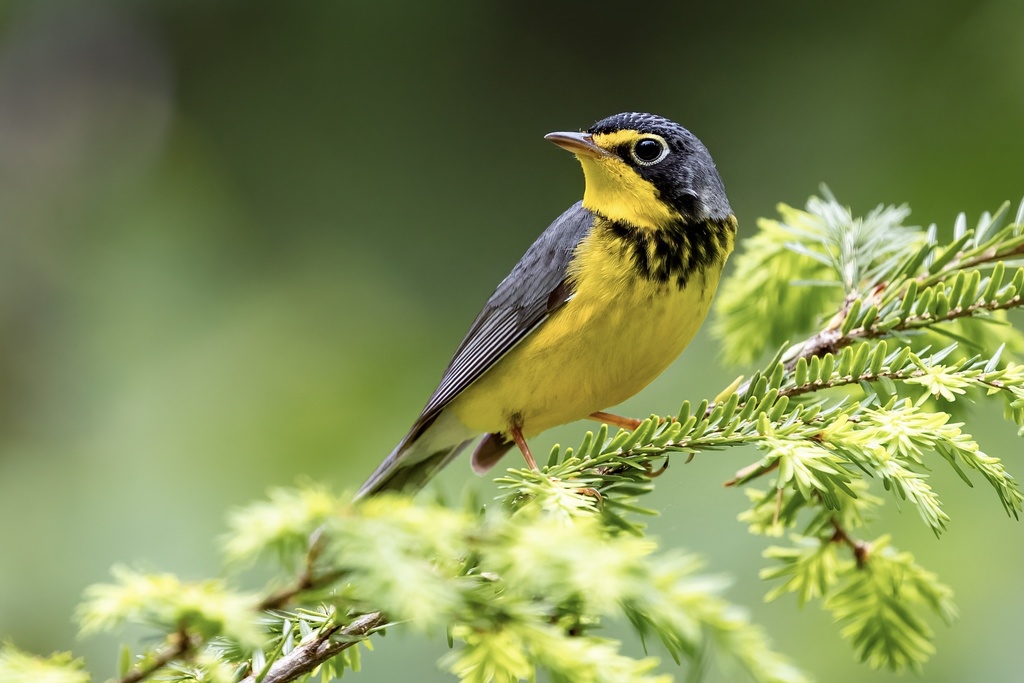
Canada Warblers are commonly seen in California during migration seasons, particularly in the spring and fall. They occur in up to 9% of checklists during migrations.
These small warblers have a striking combination of gray upperparts and bright yellow underparts. They also exhibit a bold necklace of black streaks across their yellow breast.
Cardellina canadensis
Length: 4.3-5.1 inches (11-13 cm)
Weight: 0.3-0.4 ounce (8-11 g)
Wingspan: 6.7-7.5 inches (17-19 cm)
Canada Warblers breed in the boreal forests of Canada and parts of the northeastern United States. They migrate through California on their way to their wintering grounds in northern South America.
These warblers prefer moist woodlands, thickets, and understory vegetation. They primarily feed on insects, spiders, and small fruits.
Canada Warbler Song:
Credit: Ryan P. O’Donnell, XC632669. Accessible at www.xeno-canto.org/632669.
Nests of Canada Warblers are built on or near the ground, hidden among vegetation. They are constructed using twigs, grass, bark, and plant fibers, and lined with fine grasses, moss, and hair. They lay around three to five eggs, which hatch after approximately two weeks. The young leave the nest within ten days.
To attract Canada Warblers, provide suitable habitat with dense vegetation, as well as insects and small fruits as a food source.
Fun Fact: The Canada Warbler is known for its unique breeding behavior. Males build multiple nests, and females select one to lay eggs in, while the male maintains and defends the remaining nests.
25. Prothonotary Warbler:

Prothonotary Warblers can be observed in California during migration seasons, particularly in the spring and fall. They occur in up to 5% of checklists during migrations.
These warblers have a vibrant golden-yellow plumage, with a blue-gray back and wings. They also exhibit a distinctive white eye ring.
Protonotaria citrea
Length: 4.3-5.1 inches (11-13 cm)
Weight: 0.3-0.4 ounce (9-11 g)
Wingspan: 6.7-7.5 inches (17-19 cm)
Prothonotary Warblers breed in the southeastern parts of the United States and migrate through California on their way to their wintering grounds in Mexico, Central America, and northern South America.
These warblers prefer swampy forests, wetlands, and wooded streams. They primarily feed on insects, spiders, and small crustaceans.
Prothonotary Warbler Song:
Credit: David Vander Pluym, XC647253. Accessible at www.xeno-canto.org/647253.
Nests of Prothonotary Warblers are usually built in tree cavities or nesting boxes near water. They are constructed using moss, bark, plant fibers, and leaves, and lined with soft materials such as feathers and hair. They lay around four to seven eggs, which hatch after approximately two weeks. The young leave the nest within ten days.
To attract Prothonotary Warblers, provide nesting boxes near water sources, as well as insects and small crustaceans as a food source.
Fun Fact: Prothonotary Warblers are the only eastern warblers that build their nests in cavities rather than in trees or shrubs.
26. Dickcissel:
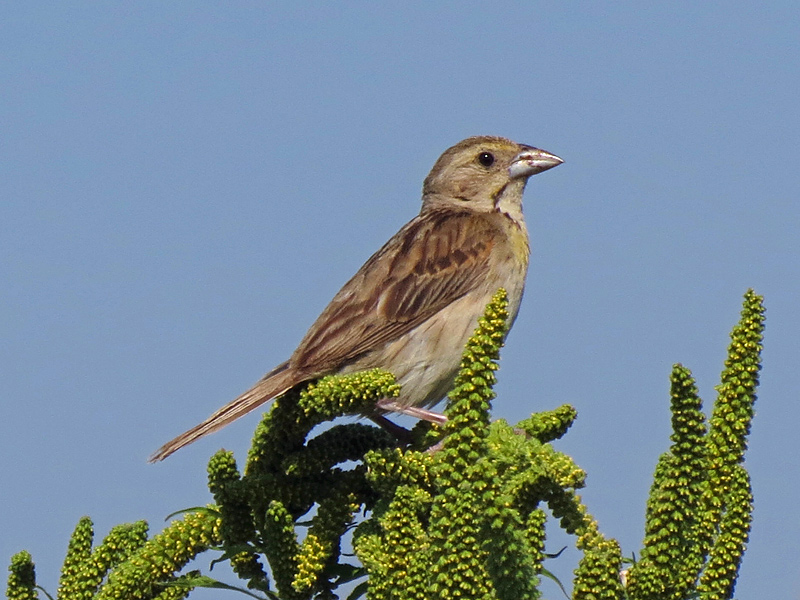
Dickcissels are commonly seen in California during migration seasons, particularly in the spring and fall. They occur in up to 7% of checklists during migrations.
These medium-sized birds have a combination of yellow underparts, a grayish-brown back, and a distinct black bib on their throat and upper breast.
Spiza americana
Length: 5.5-6.7 inches (14-17 cm)
Weight: 0.7-1.0 ounce (20-29 g)
Wingspan: 9.8-11.0 inches (25-28 cm)
Dickcissels breed in the central parts of the United States and migrate through California on their way to their wintering grounds in southern South America.
These birds prefer open grasslands, prairies, and agricultural fields. They primarily feed on seeds, grains, and insects.
Dickcissel Song:
Credit: Andrew Spencer, XC365038. Accessible at www.xeno-canto.org/365038.
Nests of Dickcissels are built on the ground, usually hidden in vegetation or grass clumps. They are constructed using grass, stems, and plant fibers, and lined with fine grasses and hair. They lay around three to six eggs, which hatch after approximately two weeks. The young leave the nest within ten days.
To attract Dickcissels, provide open grassy areas and native plants that produce seeds, as well as insects as a food source.
Fun Fact: The name “Dickcissel” comes from the bird’s distinctive song, which sounds like the phrase “dick-dick-ciss-ciss.”
27. Prairie Warbler:
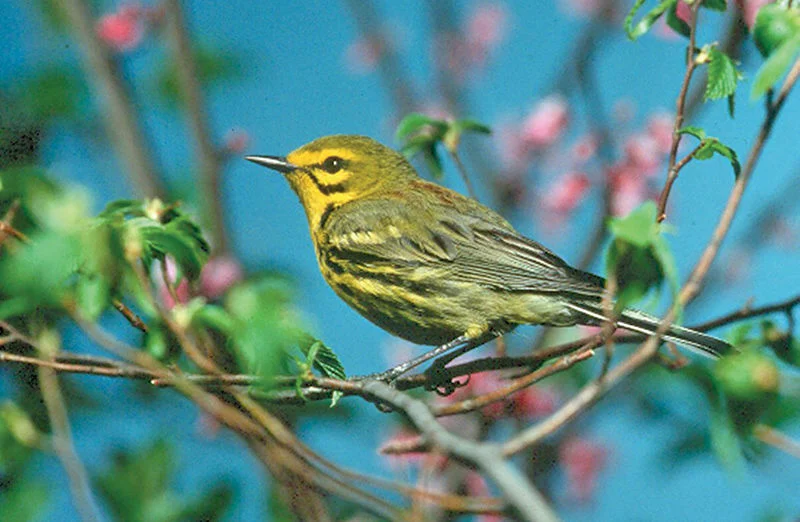
Prairie Warblers can be spotted in California during migration seasons, particularly in the spring and fall. They occur in up to 9% of checklists during migrations.
These small warblers have bright yellow underparts, a grayish-brown back, and bold black streaks on their sides and across their yellow breast.
Setophaga discolor
Length: 4.3-4.7 inches (11-12 cm)
Weight: 0.3-0.4 ounce (7-11 g)
Wingspan: 6.3-7.1 inches (16-18 cm)
Prairie Warblers breed in the eastern parts of North America and migrate through California on their way to their wintering grounds in the Caribbean and Central America.
These warblers prefer shrubby habitats, open woods, and overgrown fields. They primarily feed on insects, spiders, and berries.
Prairie Warbler Song:
Credit: Jonathon Jongsma, XC601572. Accessible at www.xeno-canto.org/601572.
Nests of Prairie Warblers are built by females, usually low to the ground in shrubs or small trees, using grass, bark, and plant fibers. They lay around three to five eggs, which hatch after approximately two weeks. The young leave the nest within ten days.
To attract Prairie Warblers, provide suitable habitat with shrubs and trees, as well as insects and berries as a food source.
Fun Fact: Prairie Warblers are one of the few warbler species that construct their nests on or near the ground.
28. Pine Warbler:
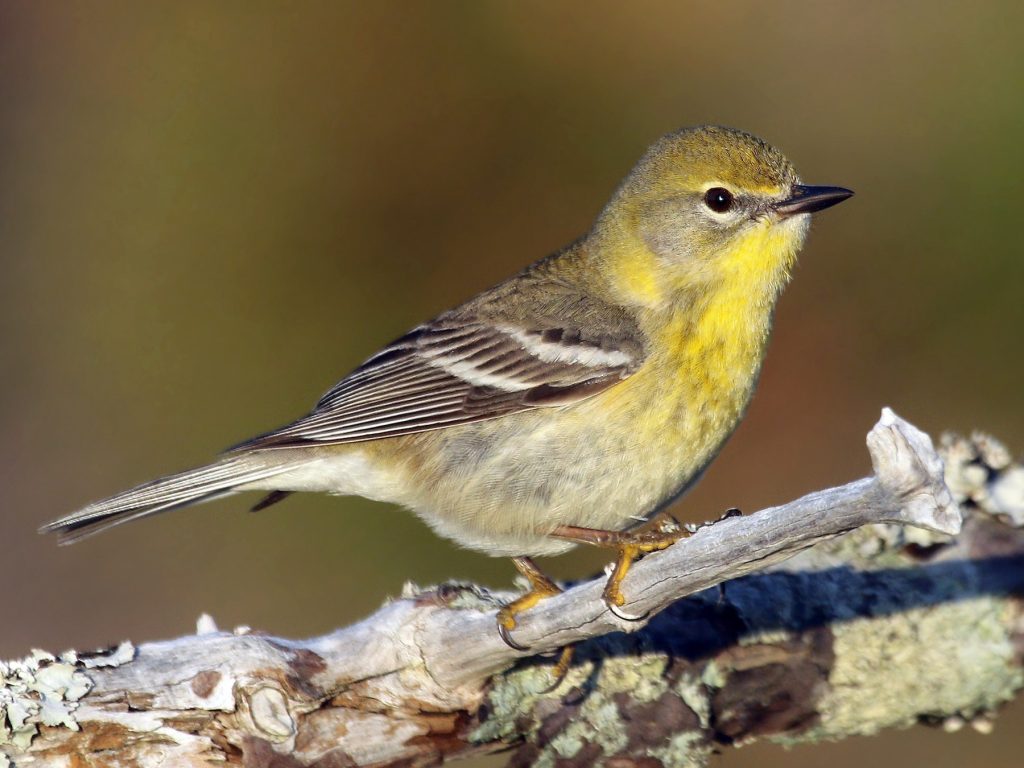
Pine Warblers can be observed in California during migration seasons, particularly in the spring and fall. They occur in up to 7% of checklists during migrations.
These medium-sized warblers have a yellow overall plumage with greenish-brown streaks on their back and wings. They also exhibit a white throat and belly.
Setophaga pinus
Length: 4.7-5.5 inches (12-14 cm)
Weight: 0.4-0.5 ounce (11-14 g)
Wingspan: 8.3-9.4 inches (21-24 cm)
Pine Warblers breed in the eastern parts of North America and migrate through California on their way to their wintering grounds in the southeastern United States and Mexico.
These warblers prefer pine forests, mixed woodlands, and forest edges. They primarily feed on insects, spiders, and seeds.
Pine Warbler Song:
Credit: Bob McGuire, XC393246. Accessible at www.xeno-canto.org/393246.
Nests of Pine Warblers are usually built high in pine trees, using pine needles, twigs, and grass, and lined with softer materials such as feathers and hair. They lay around three to five eggs, which hatch after approximately two weeks. The young leave the nest within ten days.
To attract Pine Warblers, provide suitable pine forest habitat, as well as insects and seeds as a food source.
Fun Fact: Pine Warblers are known for their ability to extract seeds from pine cones, which they often hang on tree branches while foraging.
29. Scarlet Tanager:

Scarlet Tanagers can be seen in California during migration seasons, particularly in the spring and fall. They occur in up to 7% of checklists during migrations.
Male Scarlet Tanagers display a vibrant scarlet plumage, with black wings and tail. Females exhibit a yellow-green coloration.
Piranga olivacea
Length: 6.3-7.1 inches (16-18 cm)
Weight: 0.9-1.0 ounce (25-28 g)
Wingspan: 10.6-11.4 inches (27-29 cm)
Scarlet Tanagers breed in the eastern parts of North America and migrate through California on their way to their wintering grounds in northern South America.
These birds prefer deciduous forests, woodlands, and edges of forests. They primarily feed on insects, spiders, and fruits.
Scarlet Tanager Song:
Credit: Matthew R. Medler, XC675000. Accessible at www.xeno-canto.org/675000.
Nests of Scarlet Tanagers are built by females, usually high in trees, using twigs, grass, bark, and other plant materials. They lay around three to four eggs, which hatch after approximately two weeks. The young leave the nest within two weeks as well.
To attract Scarlet Tanagers, provide suitable forested habitat with mature trees, as well as insects and fruits as a food source.
Fun Fact: Male Scarlet Tanagers undergo a molt during migration, changing their plumage from bright red to a yellow-green color similar to females before reaching their wintering grounds.